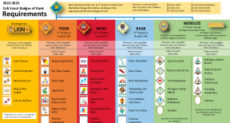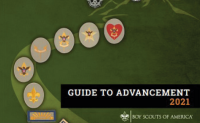 As we move forward into 2020, the Boy Scouts of America’s advancement team is out with a few reminders and new advice on the ongoing quest for one of our most visible methods – advancement.
As we move forward into 2020, the Boy Scouts of America’s advancement team is out with a few reminders and new advice on the ongoing quest for one of our most visible methods – advancement.
- The evolution of Scoutbook brings us new opportunities to manage our programs. For example, the Den Leader Experience Tool will soon allow den leaders to better visualize their den program by scheduling meetings around the topic of each required Adventure and to set up meetings covering the elective Adventures as well. Once entered, the system allows the completion of each Adventure to be automatically posted for Scouts who attend and participate. The calendar can be distributed to parents, so they’ll know what is going to be covered at each den meeting, further streamlining the process and allowing parents to plan to help their Scout complete the requirements covered at a meeting where the Scout was absent. The demo mode lets den leaders preview what the site looks like, create a sample calendar and post advancement. There are also helpful videos on a variety of topics from rank requirements to managing your den and maintaining order at den meetings. (I wish we had these tools when I was a den leader!)
- There’s updated guidance on the temporary transition rules for new members entering ScoutsBSA. The rules, announced earlier, allow for an extension of time for certain older youth who join to complete the requirements for the Eagle Scout rank.
- In an article titled The Power of Suggestion, adult leaders are cautioned about making “suggestions” to Scouts in a manner that they carry the weight of a requirement instead. An example given cites frequently-discussed guidelines for the amount of time to be spent working on an Eagle Scout leadership service project. If the Scoutmaster suggests, say, one hundred hours, the Scout is likely to interpret that as an expectation, in much the same way that a “suggestion” from your boss that the report you’re working on should be completed today is likely taken as a directive. Put yourself in the place of the youth, who look up to and take direction from adults as a matter of course, and find another way to express what you’re saying. When you think about it, setting the expectation of one hundred hours for an Eagle project also implies that merely putting in those hours meets the requirement, regardless of effort expended or leadership demonstrated. Emphasize the actual requirement, praise incremental progress, and offer guidance through asking thoughtful questions.
- The topic of receiving dual credit for awards earned in Venturing and ScoutsBSA is discussed. While ranks up through First Class must be earned while registered in ScoutsBSA, the requirements for Star, Life and Eagle Scout can also be earned through participation in a Venturing crew or a Sea Scout ship up through age eighteen.
- There’s ongoing advice on handling group instruction of merit badges, a topic which I’ve discussed previously, including the caveats cited in the Guide to Advancement regarding the use of registered Merit Badge Counselors, the expectation that requirements may only be partially completed in the session and follow-up visits with a counselor may be required to finish the badge, and the requirement that each Scout must individually demonstrate completion of the requirements for which credit is given.
- The concept of positions of responsibility for Cub Scouts is introduced, following a yearlong study of how the methods of Scouting are enhanced through leadership roles taken on by youth. While no specifics are given, and while the only formal youth position of responsibility in Cub Scouting is the Denner, it bears watching to see what the research finds. Many informal roles can be implemented in Cub Scouting, such as flag detail leader, skit leader, snackmaster, and others.
The January-February Advancement News can be read here.
This post first appeared on Bobwhite Blather.





